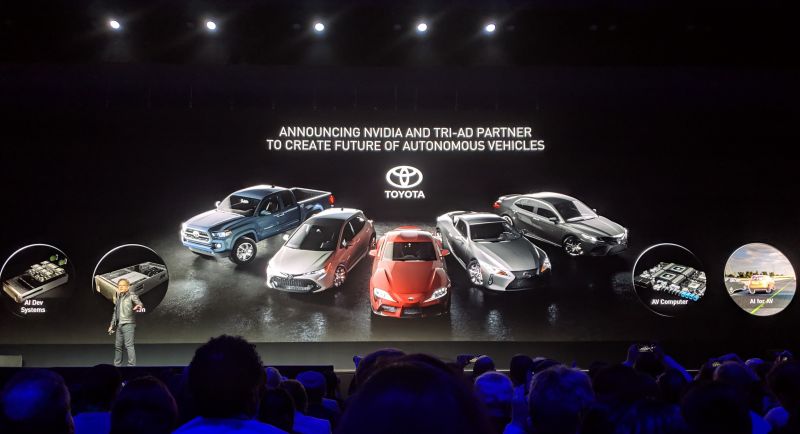NVIDIA to Partner with Toyota Research Institute AD to Develop Self-Driving Vehicles
【Summary】NVIDIA CEO Jensen Huang delivered the opening keynote at Nvidia’s annual GTC conference in Silicon Valley on Monday to share some of the advanced projects his company is working on. Among yesterday's major announcements is a new partnership between Nvidia and the Toyota Research Institute Advanced Development (TRI-AD) to develop, train and validate self-driving vehicles.

NVIDIA CEO Jensen Huang delivered the opening keynote at Nvidia's annual GPU technology conference in Silicon Valley on Monday to share some of the advanced projects his company is working on.
Among the major announcements in Huang's nearly 3-hour-long keynote is a new partnership between Nvidia and the Toyota Research Institute Advanced Development (TRI-AD) to develop, train and validate self-driving vehicles.
Huang announced that TRI-AD will leverage Nvidia's advanced DRIVE Zavier platform, the world's first processor designed for autonomous driving which was first announced at last year's GTC.
"Self-driving vehicles for everyday use and commercial applications in countless industries will soon be commonplace. Everything that moves will be autonomous. Producing all these vehicles at scale will require a connected collaboration for all elements of the system. Our relationship with TRI-AD and TRI is a model for that collaboration." Huang said in a statement.
The automotive-grade Xavier system-on-a-chip (SoC) incorporates six different types of processors to run redundant and diverse algorithms for AI, sensor processing, mapping and driving, which are all technologies that make self-driving cars possible.
The Xavier SoC can fuse data from a variety of sensors to anticipate potential hazards on the road, enabling Level 2 and higher automated driving systems. It processes data from a self-driving vehicle's cameras, lidar, radar, and ultrasonic sensors to understand the complete 360-degree environment. It allows a self-driving vehicle to precisely find its position on a map.
The partnership builds on an ongoing relationship with Toyota to incorporate the NVIDIA DRIVE AGX Xavier AV computer. Teams from NVIDIA, TRI-AD in Japan and Toyota Research Institute (TRI) in the United States will collaborate on the initiative.
The agreement includes the development of an architecture for autonomous vehicles that can be scaled across many vehicle models and types, accelerating the development and production timeline. Nvidia's DRIVE AGX platform is capable of simulating billions of miles of real-world driving, to validate deep learning algorithms in challenging traffic scenarios without having to deploy test vehicles on public roads.
"Our vision is to enable self-driving vehicles with the ultimate goal of reducing fatalities to zero, enabling smoother transportation, and providing mobility for all," said Dr. James Kuffner, CEO of TRI-AD. "Our technology collaboration with NVIDIA is important to realizing this vision. We believe large-scale simulation tools for software validation and testing are critical for automated driving systems."
Simulation has proven to be a valuable tool for safe testing and validating of autonomous vehicle hardware and software before it is put on the road. TRI-AD and TRI will utilize the NVIDIA DRIVE Constellation platform for their simulation workflow.
The Constellation simulator produces a photo realistic real-world driving environment for testing self-driving vehicles. Developers can add weather elements such as rain, direct sunlight, as well as other vehicles to test how a autonomous vehicles sensors can handle conditions in the real-world.
AI and deep-learning have become a vital tool for developing of next-generation automated vehicles and are used to teach a self-driving car to recognize and handle an infinite number of scenarios encountered on the road, including rare edge cases.
DRIVE Constellation is installed in a data center and is comprised two side-by-side servers. The first server runs the Constellation Simulator, using NVIDIA GPUs running to generate the sensor output from a virtual car driving in a realistic virtual world.
The second server contains the DRIVE AGX car computer, which processes the simulated sensor data. The driving decisions from Constellation Vehicle are fed back into Constellation Simulator, aiming to realize bit-accurate, timing-accurate hardware-in-the-loop testing.
The end-to-end simulation toolchain from Nvidia will help enable Toyota, TRI-AD and TRI to safely bring automated vehicles to market.
resource from: NVIDIA
-

Electric Nissan Juke: A Sneak Peek at the Future
-

Electric cars set to become more affordable
-

Major creditor in talks to acquire Volta Trucks
-

Chinese EV maker's valuation close to Tesla
-

EVs' Limited Success in the U.S., Excluding Teslas
-

Toyota's Dedication to Quality Shines in Century Bolt Tightening Process
-

Tragic Accident: Bentley's Speed Questioned in Niagara Falls Deaths
-

Accelerating Car Development with Mazda-backed AI Firm
- EV Startup Fisker Announces ‘Fisker Finance’ a Digital Financing Platform for Purchasing the Electric Ocean SUV
- Ford to Use Lithium Iron Phosphate Batteries for the First Time as it Aims to Produce 600,000 EVs a Year in 2023, Sets Up Global Supply Chain
- Chevrolet Bolt EV, Bolt EUV Get Dramatic Price Cuts
- China's Tech Giant Baidu Plans to Rollout the World’s Largest Fully Autonomous Ride-Hailing Service by Next Year
- China Added 963,000 Electric Vehicle Charging Piles Since January in its Push to Lead the World in EV Sales
- Tesla Rival XPeng Inc. to Start Deliveries of its New Flagship G9 Electric SUV in September, CEO Confirms After Sharing New Details
- The BMW 7-Series to Feature HD Live Maps From HERE Technologies for Hands-Free Highway Driving in North America at Speeds up to 80 MPH
- Toyota’s Redesigned Prius May Get More Drivers Behind the Wheel of a Hybrid Vehicle
- New Premium Electric Vehicle Brand Zeekr Is Exploring IPO Options in the U.S. or Hong Kong, According to Sources
- Ford CFO Claims Inflation Has Erased Mustang Mach-E Profits



















 About Us
About Us Contact Us
Contact Us Careers
Careers